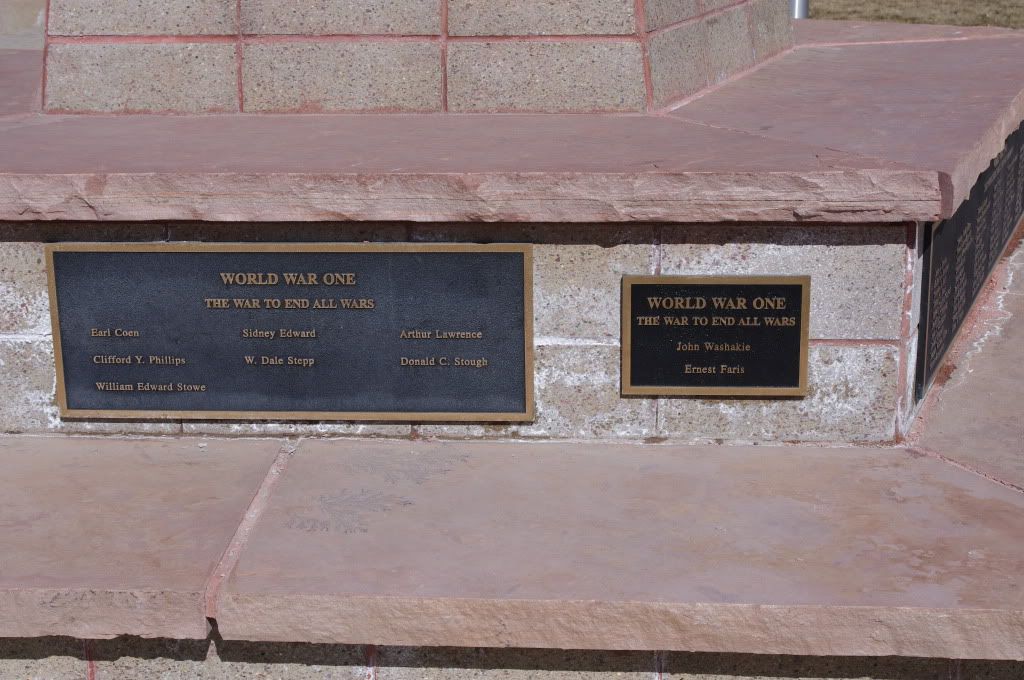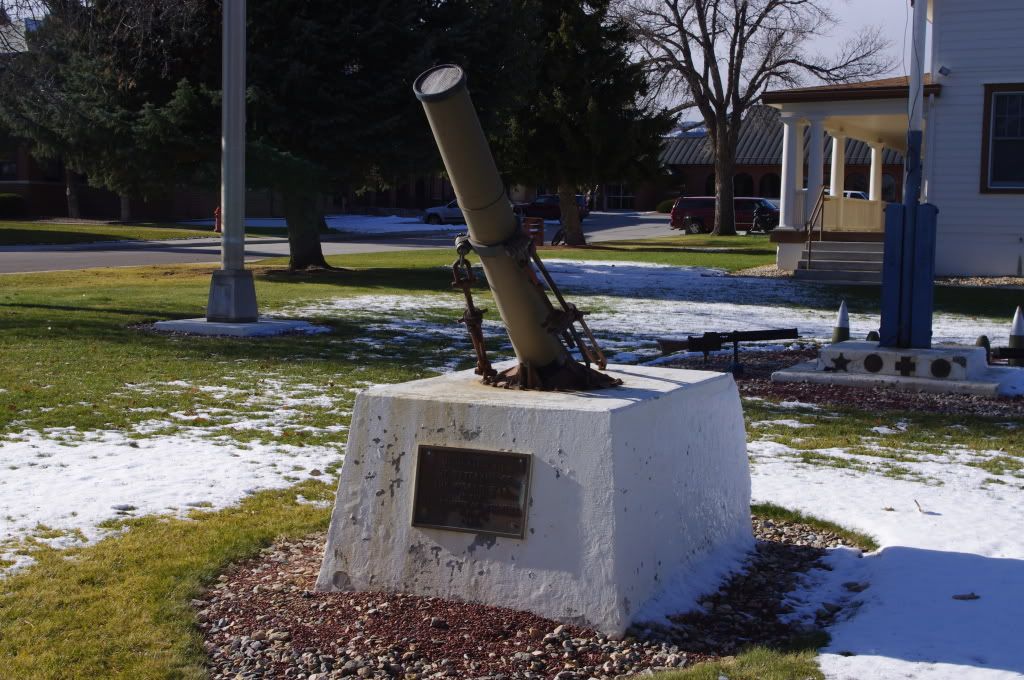Re: Great War Memorials
Posted: Thu Nov 11, 2010 12:38 pm
Bumped up in remembrance of November 11, 1918.Pat Holscher wrote:
Pat
Bumped up in remembrance of November 11, 1918.Pat Holscher wrote:
Pat

That's a great one!dekenai wrote:Beersheba, Israel 2009, celebrating the charge of 1917 by Australian Lighthorse.
Thanks.Camp Little wrote:The Spirit of the American Doughboy
These statues may be found over many locations in the US. I've seen one Pat in Rock Springs, WY while passing through the area on a hunting trip. There is another just outside Soldier Field in Chicago Here are a few links to the story behind the statues:
http://en.wikipedia.org/wiki/Spirit_of_ ... n_Doughboy
http://doughboysearcher.weebly.com/the- ... ghboy.html
I picked up one of the pot metal ones that was missing a hand and had a few gouges in the metal. I was able to pick up a replacement hand and restore it. I'll try to post a picture if I can figure out the new system.
I just saw this one and find it remarkable. Rarely, in a sculpture, do you see the riders position truly correct, but this one is perfect. Leg under and seat back, in a very balance position. It also looks like he might have a handful on mane. Very well done and the detail is wonderful.dekenai wrote:Beersheba, Israel 2009, celebrating the charge of 1917 by Australian Lighthorse.

What is the structure behind the bucking horse statue?Pat Holscher wrote:This is an unusual one which features a small statute of a horse saddled with a McClellan saddle:
http://warmonument.blogspot.com/2012/03 ... addle.html
The image is somewhat dark, so it's hard to get the details of the saddle, but you can see the photograph of the men who went from Jackson Wyoming to Cheyenne to enlist in World War One. The memorial indicates that they were a "troupe" but I don't know what that means in this context.
Jackson was organized as a town in 1914, although it's a little older than that. At that time, getting in and out of it during the winter was impossible, so these guys were probably as tough as nails.
Teton County's memorial features Steamboat, the famous bucking horse:
http://warmonument.blogspot.com/2012/03 ... ckson.html
That is an arch made of cast elk horns. They are easily gathered en masse from the refuge where the elk are dammed up and fed through the winter.Couvi wrote:What is the structure behind the bucking horse statue?Pat Holscher wrote:This is an unusual one which features a small statute of a horse saddled with a McClellan saddle:
http://warmonument.blogspot.com/2012/03 ... addle.html
The image is somewhat dark, so it's hard to get the details of the saddle, but you can see the photograph of the men who went from Jackson Wyoming to Cheyenne to enlist in World War One. The memorial indicates that they were a "troupe" but I don't know what that means in this context.
Jackson was organized as a town in 1914, although it's a little older than that. At that time, getting in and out of it during the winter was impossible, so these guys were probably as tough as nails.
Teton County's memorial features Steamboat, the famous bucking horse:
http://warmonument.blogspot.com/2012/03 ... ckson.html
That's right. There are four such arches on this small town block, one at each corner.selewis wrote:That is an arch made of cast elk horns. They are easily gathered en masse from the refuge where the elk are dammed up and fed through the winter.Couvi wrote:What is the structure behind the bucking horse statue?Pat Holscher wrote:This is an unusual one which features a small statute of a horse saddled with a McClellan saddle:
http://warmonument.blogspot.com/2012/03 ... addle.html
The image is somewhat dark, so it's hard to get the details of the saddle, but you can see the photograph of the men who went from Jackson Wyoming to Cheyenne to enlist in World War One. The memorial indicates that they were a "troupe" but I don't know what that means in this context.
Jackson was organized as a town in 1914, although it's a little older than that. At that time, getting in and out of it during the winter was impossible, so these guys were probably as tough as nails.
Teton County's memorial features Steamboat, the famous bucking horse:
http://warmonument.blogspot.com/2012/03 ... ckson.html
An example of what Sandy is referring to:Pat Holscher wrote:That's right. There are four such arches on this small town block, one at each corner.selewis wrote:
That is an arch made of cast elk horns. They are easily gathered en masse from the refuge where the elk are dammed up and fed through the winter.
I think I'd relate the story a bit differently, but with some of the same basic features. The town of Jackson ("Jackson Hole" is the valley and the town's just Jackson) is the cork in the bottle and has been since the early 20th Century. It's built in the logical place, more or less, but it did cork up the valley. This resulted in the loss of over half of this particular herds winter grazing grounds, and there were huge die offs due to starvation in the early 20th Century. The loss wasn't due to hunting, however, but due to winter kill. The winter kills of the few years prior to 1912 were so bad that the ranchers in the valley began to feed them hay in the winter. By 1912, however, they no longer could afford to do that. The (fairly small) ranchers in the valley of that period were really hard scrabble places, as the entire valley was closed off from the outside during winter at that time. As they were having a hard time feeding their cattle, by 1912 they couldn't do it alone and petitioned the Legislature. The 1912 time frame fits into the Theodore Roosevelt era of conservation, and by that time the concept of regulated big game hunting had come in and was being very much advanced by hunters, so there wasn't actually any desire to simply kill the elk off and the concept of preserving the game herds was developed and had the regional support at that time.selewis wrote:Nice pics Pat, thanks.
A bit of back story, Couvi. The city of Jackson Hole is a cork in the bottleneck of the elk's migration route. Being grazers like cows, once upon a time they moseyed through town on their way down to their winter range on the flats of south eastern Idaho. When Jackson Hole became civilized, to the extent that the city mothers got fed up with the beasts trampling through their flower beds on their return trip in the spring, it was decided, in the sensible spirit of the times, that the best way to restore domestic bliss to the community would be to shoot all the elk. Times change though; and just in time for the elk's sake. That plan was shelved and they put up a big fence instead. Hence: the elk refuge, a large meadow, a natural holding pen where they are fed through the winter. The Boy Scouts collect the antlers after they are shed in the spring and they are auctioned off to furniture makers, artists, oriental druggists, whomever.